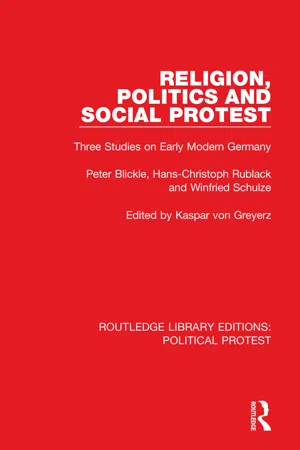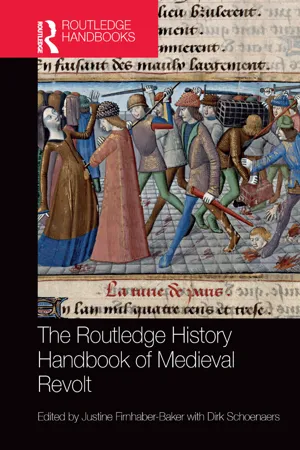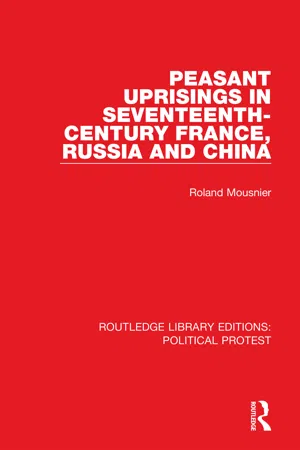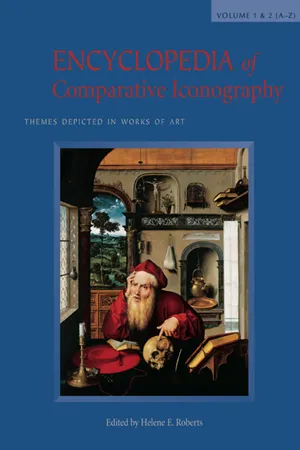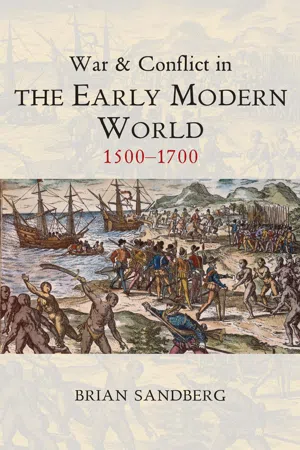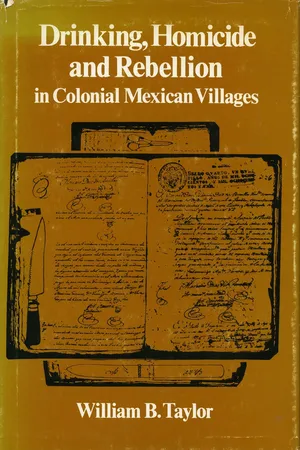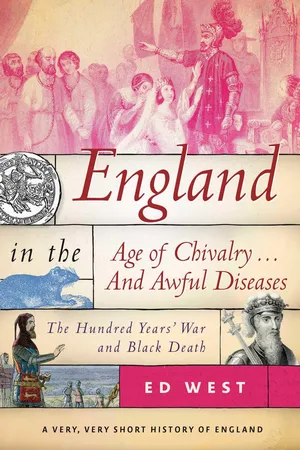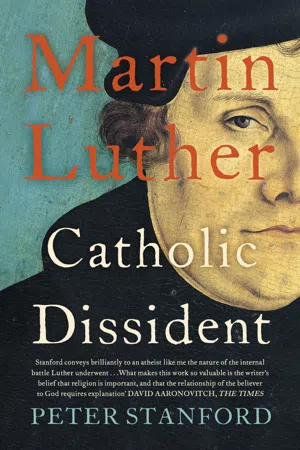History
Peasants Revolt
The Peasants' Revolt was a major uprising in medieval England in 1381. It was sparked by widespread discontent among the peasant population due to oppressive taxation and social inequality. Led by figures like Wat Tyler and John Ball, the revolt resulted in violent clashes and demands for political and economic reforms, ultimately shaping the course of English history.
Written by Perlego with AI-assistance
Related key terms
Related key terms
1 of 4
Related key terms
1 of 3
11 Key excerpts on "Peasants Revolt"
- eBook - ePub
- John H. Kautsky(Author)
- 2017(Publication Date)
- Routledge(Publisher)
52 Even if, as Eberhard says, there were peasant rebellions almost every year in China, evidently the empire with the greatest number of such rebellions, only a tiny fraction of all the many millions of Chinese peasants in the more than two millennia since the end of the feudal Chou period could have been involved in them.Notes1. Such distinctions can exist in traditional aristocratic empires, but they tend to become more prominent only with commercialization, as was true in China and in late medieval Europe. On the complex legal, economic, and social divisions of the peasantry in thirteenth-century England, see Homans, English Villagers of the Thirteenth Century, pp. 232–52.2. Wolf, Peasants, pp. 10–11, 3–4.3. Shanin, “Peasantry as a Political Factor,” p. 240. Redfield, throughout his classic Peasant Society and Culture, refers to peasant societies as “part-societies” understandable only in relation to cities and larger societies. Earlier, he had argued that the word peasant “points to a human type.… It required the city to bring it into existence. There were no peasants before the first cities. And those surviving primitive people who do not live in terms of the city are not peasants.” Redfield, The Primitive World and Its Transformations, p. 31.4. Moore, Social Origins of Dictatorship and Democracy, p. 111n.5. Redfield, Peasant Society and Culture, p. 27. Heilbroner says: “A peasant is a social creature very different from a farmer. He is not technologically alert but, on the contrary, clings with stubborn persistence—and often with great skill—to his well-known ways. He must, since a small error might mean starvation. He does not buy the majority of his supplies but, to a large extent, fashions them himself; similarly, he does not produce for a ‘market,’ but principally for himself. Finally, he is often not even free to consume his own crop, but typically he must hand over a portion—a tenth, a third, half or even more—to the owner of his land.” Heilbroner, The Making of Economic Society - eBook - ePub
Contention in Context
Political Opportunities and the Emergence of Protest
- James M. Jasper, Jeff Goodwin(Authors)
- 2011(Publication Date)
- Stanford University Press(Publisher)
Combining his analysis of these two data sets with an examination of the debates and actions that occurred in the National Assembly, the Legislative Assembly, and the Convention, Markoff claims that the destruction of seigneurial dues, monopolies, and rights was neither the primary initial goal of the peasantry, nor the inevitable outcome of the Third Estate attack on noble privilege. Rather, the peasantry and the Third Estate forced or encouraged each other to go further in a give-and-take of insurrection and legislation from 1789 to 1793, until in the end the surviving feudal seigneurial rights were wholly abolished without any compensation. It was the course of this give-and-take, rather than any structural predisposition or enabling factors, and not the simple breakdown of coercive authority, that determined the timing and nature of peasant protests during the Revolution.Origins of the Peasant Movement
Markoff establishes the initial goals and actions of the peasantry from 1788 through the summer of 1789—what we might call the insurrectionary ideology of the peasantry—from the targets of complaint in the cahiers of the rural parishes. The initial actions, the practical aspect of peasant insurrection during this period, are classified from the survey of actions by rural groups.Despite the massive attention given to the French Revolution as bringing about the “end of feudalism,” in the spring of 1789 this was hardly the peasantry’s main concern. Of the complaints in the rural cahiers , only 10 percent of the listed complaints focus on payments made under the seigneurial regime, and merely 4 percent on the clerical tithes and church exactions (casuels ), while 32 percent focus on taxes (Table 2.2, p. 41). Of the eleven topics most often mentioned in the rural cahiers , seven are explicitly about taxation. Taxation in general is mentioned most frequently, followed by the salt tax, the tax on alcoholic beverages, the tax on legal acts, the taille (land tax paid by commoners), the tax advantages of the clergy, and the tax advantages of the nobility. The salt monopoly, the royal corvée - eBook - ePub
Religion, Politics and Social Protest
Three Studies on Early Modern Germany
- Peter Blickle, Hans-Christoph Rublack, Winfried Schulze, Kaspar von Greyerz(Authors)
- 2021(Publication Date)
- Routledge(Publisher)
58A purely chronological survey of the numerous local and regional revolts and resistance movements risks leaving movements of this kind unexplained. This approach suggests that the interest of historians in these movements is restricted to their regional effects, overlooking their wider political and social implications. Indeed, at first sight, the economic, social and political conditions under which revolts occurred and the forms which they took seem too varied to produce a coherent pattern such as has been established for France in the model of the ‘anti-fiscal’ revolts.59These well-founded reservations have influenced research in this field. Nevertheless, certain underlying tendencies can be discerned in the history of the peasant revolts between the Peasants’ War and the French Revolution. First there is an obvious cluster of revolts in the Upper German area. The Upper Rhine, the Black Forest, Upper Swabia and the Habsburg lands undoubtedly experienced the greatest frequency of resistance and these revolts were also the most extreme. On the other hand, the frequency of revolts in the western, northern and eastern territories was much lower. In the central German area most revolts occurred in the seventeenth and eighteenth centuries.These regional divisions are significant, because they reflect the extent of the Peasants’ War of 1524-6. Nevertheless, a more useful approach is to assess whether there is a correlation between the size of the territorial states involved and the frequency of the uprisings. Even at first sight it is striking that the smaller territories were more seriously affected by revolts than the medium-sized or larger ones. This is illustrated by the revolts which took place in the following areas: Upper Germany (1580-1620), Solms-Greifenstein and Solms-Braun-fels (1650-1729), the county of Schönburg (1650-81), Greiz (1714-30), Anhalt-Bernburg (1752), Schwarzburg-Rudolstadt (1627, 1716-36), Schaumburg-Lippe (1784-93), the counties of Sayn-Wittgenstein (1697-1725), Nassau-Weilburg and Isen-burg-Meerholz (1718-73), the Bishopric of Kempten (1666-7 and 1721-31), the knights’ estates at Illereichen (1653-61), the estate at Triberg in the Black Forest (1642-54),60 the county of Hauenstein (‘Saltpeter’ disturbances) and the Hohenzollern counties in the eighteenth century. Numerous other examples could be cited, particularly if we include the procedural disputes of the eighteenth century. Our analysis of the published sources leads to the conclusion that smaller territories were more susceptible to revolts than larger ones.61 This conclusion is supported by evidence drawn from the judgements of the Reichshofrat - Justine Firnhaber-Baker, Dirk Schoenaers, Justine Firnhaber-Baker, Dirk Schoenaers(Authors)
- 2016(Publication Date)
- Routledge(Publisher)
INTRODUCTION Medieval revolt in contextJustine Firnhaber-BakerThis anthology is part of an emerging body of historiography devoted to late medieval uprisings and to popular politics more generally that has developed since the turn of the millennium. These topics, hotly contested in the 1970s and 1980s, had fallen out of vogue in the previous decade, as attention shifted from classical social and political history to new kinds of cultural history. The renewed attention to medieval revolts reflects the return of political history to the fore since the new millennium but in a very different way, as our understanding of the state and violence has undergone a thorough revision and as the insights of the cultural turn have transformed how we read the events that made up a rebellion and the sources that report them. Continental scholars, often in the earlier stages of their careers, have been particularly prominent producers of new work on medieval revolt, publishing a series of inter-related essay collections.1 The 2006 publication of Samuel K. Cohn, Jr.’s Lust for Liberty: The Politics of Social Revolt in Medieval Europe has also galvanised much scholarship, particularly among Anglophones.2 The fruit of this work, often pursued collaboratively, has rapidly pushed the study of revolt in a number of new directions, which we hope not only to showcase here, but also to drive forward by bringing together work from a dynamic group of historians (plus a classicist and a literary scholar) from continental Europe, North America, and the UK.The aims of our work in this volume are heuristic and exploratory rather than definitive. There is an overall consensus among the authors here that our approach to medieval uprisings must take account of their actors’ agency within their historically specific societies, but also that our access to those actors and societies is mediated – and often obscured – by the texts that report them. From these agreed methodological starting points, our investigations move in a variety of directions and work to raise questions, as well as to answer them. Drawing on instances of revolt from Ireland to Syria and from periods to either side of the later Middle Ages as well as the core centuries from 1250 to 1500, contributors think about how uprisings worked, why they happened, whom they implicated, what they meant to contemporaries, and how we might understand them now.- Roland Mousnier(Author)
- 2021(Publication Date)
- Routledge(Publisher)
Revue des Travaux de l’Académie des Sciences morales et politiques, ler trim. (1962), pp. 28-43.If one were to say: “Circumstances suffice to explain the peasant revolts in these three countries in the seventeenth century. Similar conditions would have provoked such outbreaks in any kind of society, would have brought about crises of despair like these anywhere at all, and, consequent upon them, sudden and repeated explosions of anger; the social structures are not to blame,” one would be putting forward an idea which, though perhaps mistaken, has nothing scandalous about it, and deserves careful examination.Revolts and Social Structures
Explanations of these revolts by reference to the social and political structure have already been put forward. The British historian Trevor-Roper, considering in particular the European political revolutions between 1640 and 1660, thought that they marked the end of the Renaissance and the beginning of the Age of Enlightenment, that they were themselves the culmination of a prolonged crisis in the structures of society. The Renaissance state, with its Court and its bureaucratic apparatus of agents who were paid, to a certain extent, by what they took for themselves, weighed too heavily upon society. This burden became unbearable during the economic recession of the seventeenth century, and various social groups endeavored to get it off their backs by way of revolt and revolution. The estates rebelled against the Court. The latter tried not only to break the rebellions but also to remove the cause of them by adjusting, through mercantilism, the charges of the bureaucrats against the resources of the country. In answer to Trevor-Roper it has been pointed out that expenditure on the Court and the agents of the state was not the heaviest item of expenditure, that members of the Court and royal officials were the principal rebels, and that mercantilism was first and foremost an instrument of war against foreign states.- eBook - ePub
Encyclopedia of Comparative Iconography
Themes Depicted in Works of Art
- Helene E. Roberts, Helene E. Roberts(Authors)
- 2013(Publication Date)
- Routledge(Publisher)
Peasantry
Margaret A. SullivanDOI: 10.4324/9780203825587-89The following periods are covered in the discussion of the theme Peasantry:- ANCIENT
- MEDIEVAL
- RENAISSANCE
- SEVENTEENTH CENTURY
- NINETEENTH CENTURY
- TWENTIETH CENTURY
Jean-François Millet, The Sower, circa 1850, oil on canvas, Boston, Museum of Fine Arts, Gift of Quincy Adams Shaw through Quincy A. Shaw Jr. and Mrs. Marian Shaw Haughton. (Courtesy of the Museum of Fine Arts, Boston)The peasantry, as represented in art, has traditionally served the interests of classes other than their own. The attitudes and anxieties of the prosperous and powerful determine how they are depicted, and the peasants’ own response to the harsh, often inhuman realities of their lives is rarely in evidence. Industrious and peaceful, they swing their sickles in reliefs on the walls of Egyptian tombs, as in the Eighteenth Dynasty (1570–circa 1342 b.c.) mortuary chapel of Nakht in Thebes, Egypt; decorate the August page of Queen Mary’s Psalter in the fifteenth century; and cut golden grain in Vincent vanGogh’s Reaper(1889, after Jean-François Millet). However, the harvest song “The Peasant Speaks,” sung by Sicilian peasants and recorded in 1876, tells a different story. To the rhythmic swing of their sickles the peasants sang a vicious litany that called for all landlords to be burned, lightning to strike all priests, “punches and kicks” to rain on the artisans, and hanging for all policemen. This violent and vindictive song, hostile toward all classes, is consistent with the long and bloody history of peasant rebellions from the great Peasant War of 1525 to the uprising of the Mexican peasants in the twentieth century.Expressed in a visual medium, the viewpoint of real peasants who perform such backbreaking labor might bear little resemblance to the ways in which the peasantry are traditionally represented. The “Potemkinization” of Russian peasants in a Stalinist movie such as Traktoristy (Tractor-Drivers) is at odds with the actual response of the peasants to the collectivization of Soviet agriculture in the 1930s. The fictionalized and idealized representation of the Irish peasant in the work of William Butler Yeats and John M. Synge justifies the title of Deborah Fleming’s study, A Man Who Does Not Exist (1995 - eBook - ePub
War and Conflict in the Early Modern World
1500 - 1700
- Brian Sandberg(Author)
- 2016(Publication Date)
- Polity(Publisher)
The rural conflicts in Russia during the Time of Troubles remind us that everyday life for most humans throughout the early modern world was dominated by agrarian societies and subsistence economies. Agriculture was frequently threatened by military extractions, environmental disruptions, and meteorological disasters. Severe monetary inflation and growing populations in many parts of the world produced a series of economic crises in the late sixteenth century. A period of global cooling, known as the Little Ice Age, then exacerbated the economic deprivation and ecological disaster, producing severe famines and social chaos throughout much of the seventeenth century.Peasants in many regions responded to economic and social pressures by protesting and, at times, rebelling over crop failures, hoarding, and high prices. Many rural societies were disturbed by pervasive crime, banditry, and riots due to the ongoing crises. Studies of crowd actions in the early modern period demonstrate that peasant crowds should not be characterized as unruly “mobs,” since they were hardly mindless or traditional.3 Village inhabitants were capable of organizing armed bands, selecting their leaders, adopting specific rituals, and choosing specific forms of violence. This chapter explores everyday violence in agrarian societies, before considering peasant protest, resistance, and revolt.4Everyday Life and Rural Violence
Peasant culture has often been presented as “traditional,” based on supposedly unchanging agricultural patterns and social structures. It has frequently been assumed that agricultural societies can be defined in terms of “peasant conservatism,” which is an inflexible attitude toward agricultural innovation and social change, but social historians have revealed complexities in peasant responses to economic changes. During the sixteenth and seventeenth centuries, peasants were adapting to new farming techniques, climate change, intensive agriculture, and global plant exchanges. - William B. Taylor(Author)
- 1979(Publication Date)
- Stanford University Press(Publisher)
32 Similar grievances, especially over revised schedules of clerical fees and labor drafts, as we shall see, were associated with what appear to be religious rebellions in eighteenth-century Mexico. As Davis suggests, the range of ruler-subject relationships must be considered, in addition to the people’s perceptions of their conditions and their assumption of the mantle of holy mission, if we are to account for the timing and location of these revolts.TABLE 18 . Comparison of Village Uprisings and Agricultural Crises in Central Mexico, 1703–1811A more common explanation of Latin American peasant movements centers on “structural contradictions,” especially a combination of subordinate-group, economic deprivation, and elite intransigence.33 This explanation places the causes of revolt completely outside the villages themselves. A recent example of this approach applied to colonial Mexico is the work of Raymond Buve.34 He sees the principal “contradiction” in the land system, which he describes in terms of landed Spanish overlords and landless Indian country folk. According to Buve, this unequal relationship on the land, plus the colonial government’s oppression of peasants in defense of the landed elite, created the conditions for peasant revolts. But this hypothesis fails to fit a good deal of the evidence both for Mexico and for other parts of Latin America. Barrington Moore, among others, has noted that peasant unrest is not simply the result of massive poverty and exploitation or of the elite’s commitment to mindless repression. There are too many revolts that do not seem to follow on a period of worsening material conditions and too many rural societies living through increasing poverty without showing an increase in social violence to hazard any universal statements about economic deprivation, elite intransigence, and peasant unrest. If anything, rebellions seem to have been more common in regions and communities of Latin America that are less poverty-stricken and isolated.35- eBook - ePub
England in the Age of Chivalry . . . And Awful Diseases
The Hundred Years' War and Black Death
- Ed West(Author)
- 2018(Publication Date)
- Skyhorse(Publisher)
HAPTER NINEThe Peasants’ RevoltO n June 21, 1377, the guild masters of London rode into the Black Prince’s former palace at Kennington just across the Thames from London, and swore their loyalty to the new king, his ten-year-old son Richard of Bordeaux.A boy on the throne was a problem, and within weeks the French threatened to invade. Richard II’s reign began with a series of military failures, and from the start it was ridden with division and the crown was bankrupt. Richard would become famous as a Shakespearean lunatic, but he had inherited a terrible mess and his enemies were mostly a dreadful bunch.The most powerful was his uncle John of Gaunt, who had in the last years of his father’s reign inherited the title of Duke of Lancaster from his father-in-law Henry (Lancaster was a county palatinate and therefore virtually self-governing). Gaunt was universally hated, and, in 1376, a London mob had almost killed him, while the common people believed all sorts of rumors circulating around, such as he poisoned his first wife, which is unlikely (divorce wasn’t a big issue at the time because the chances were one spouse would die of some ghastly disease before too long).To pay for the war, a new levy was imposed called a ‘poll tax.’ There had never been a universal tax before, and they soon learned why, for, in 1381, rural anger erupted into the biggest popular uprising in English history. The peasants were revolting.Although the word was only coined in 1776 by Adam Smith, the social system at the time is generally known as feudalism, from feodum - eBook - ePub
Martin Luther
Catholic Dissident
- Peter Stanford(Author)
- 2017(Publication Date)
- Hodder Faith(Publisher)
Some 25,000 copies of the ‘Twelve Articles’ were printed and circulated around Germany. By the time they appeared, the Peasants’ War was underway, from Alsace in the west to Meissen in the east, though the majority of the conflict occurred in the south and west. There was little by way of organised leadership among the rebels, little co-ordination, and a variety of motivations for taking up arms. Some were local, some economic, some social, some religious. Some of those who rebelled were traditional Catholics, some were ‘new’ Lutherans, some from other reform-minded offshoots. Zwingli offered his support to the rising from the Swiss cantons he now controlled. And, despite it being known to history as the Peasants’ War, this was by no means a straightforward class conflict.The immediate spark for the conflagration is as hard to identify as anything else about this rising. Some point to a ‘Knights’ Revolt’ in 1522 and 1523 in the Rhineland in the west, where groups of lesser nobility vented their dislike at losing out in the pecking order to the new merchant/burgher class in the towns. They complained that their ancestral lands were lost, their military role usurped, and that the money economy in towns replacing the existing feudal system was ruining them. This revolt was in many senses an essentially conservative and backward-looking uprising, but it may have fanned the flames of wider peasant unrest.Another potential starting point was the demand by a Countess Helena Lupfen in the autumn of 1524, made on her ancestral lands in Stühlingen in the Black Forest region, that ‘her’ peasants collect snail shells. She was evidently fond of winding thread around such shells and wanted a new supply. For the peasants, however, exhausted by successive failures of the harvest, the countess’s imperious and frivolous order was the last straw. They rose up in fury and their defiance quickly spread throughout southwest Germany, merging with other simmering local issues. At Kempten in Swabia, for example, fighting broke out over a dispute concerning its status as an imperial free town and the role of the local monastery.By the spring of 1525, the Peasants’ War was at its height. Perhaps the most notorious episode came on 17 April 1525. Count Ludwig von Helfenstein, a relative by marriage of Emperor Charles, and a group of up to seventy nobles were captured by a ‘peasants’ army’ under Jacklein Rohrbach near Weinsberg. They were made to run the gauntlet and massacred. Their relatives swore revenge. - eBook - ePub
Civil and Uncivil Violence in Lebanon
A History of the Internationalization of Communal Conflict
- Samir Khalaf(Author)
- 2002(Publication Date)
- Columbia University Press(Publisher)
4 Peasants, Commoners and Clerics Resistance and Rebellion: 1820–1860“Warfare was a quicker as well as a more honorable route to riches than trade.”The mimetic character of violence is so intense it cannot burn itself out…. Only violence can put an end to violence and that is why violence is self-propagating.”—Ernest Gellner, Nationalism (1997).—René Girard, Violence and the Sacred (1977).There has been reawakened interest in the forms that peasant resistance are likely to assume, particularly in historical situations where open defiance is either impossible or entails considerable hazards (Scott 1985; Colburn 1989). Under such circumstances, it is argued, peasant resistance is prone to remain in the “hidden realm of political conflict.” Hence, it is less likely to take the form of open collective acts of violence such as riots, rebellion, sedition, or revolutionary movements. Since peasant uprisings, anyway, are “few and far in between,” it is more meaningful, Scott and Colburn tell us, to shift analysis to the more prosaic means of everyday resistance. In such instances, petitions, rallies, boycotts, sabotage, foot-dragging, false compliance, pilfering, and other such acts of resistance become part of the arsenal of relatively powerless and subordinate groups. Or, more likely, such hidden or muted hostility is seen as an expression of groups deficient in class consciousness or denied access to collective forms of mobilization. Such ordinary forms of everyday resistance become, to employ James Scott’s apt expression, the “weapons of the weak.”Lebanon’s experience with peasant uprisings is, in this regard, instructive in more than one respect. First, peasant resistance did not remain in the hidden or quietist realm of political conflict. Nor were such acts confined to the conventional forms of everyday resistance that seemingly mute and helpless social groups resort to in mobilizing protest or redressing their grievances. Second, peasants in Lebanon, perhaps more than other such insurrections in the Middle East (Baer 1982: 275), evinced attributes of collective solidarity and class consciousness rare among movements in small and highly factionalized sociocultural settings. In some instances, Christian peasants were revolting against rulers and overlords who were also Christian. Collective class-consciousness in such cases, clearly assumed primacy over confessional and fealty ties. Yet, these uprisings rarely remained in their pure form. They either merged with intercommunal tensions, rampant at the time, or were deflected into confessional hostility. It is then, as will be demonstrated, that fairly contained forms of collective protest degenerate into random and reckless belligerency. Finally, the Lebanese experience departs in a striking sense from another basic feature commonly associated with peasant revolts; namely, that they “have been repressed far more often than they have succeeded … and that for them to succeed requires a somewhat unusual combination of circumstances that has occurred only in modern times” (Moore 1966: 479–80).
Index pages curate the most relevant extracts from our library of academic textbooks. They’ve been created using an in-house natural language model (NLM), each adding context and meaning to key research topics.
Explore more topic indexes
Explore more topic indexes
1 of 6
Explore more topic indexes
1 of 4


